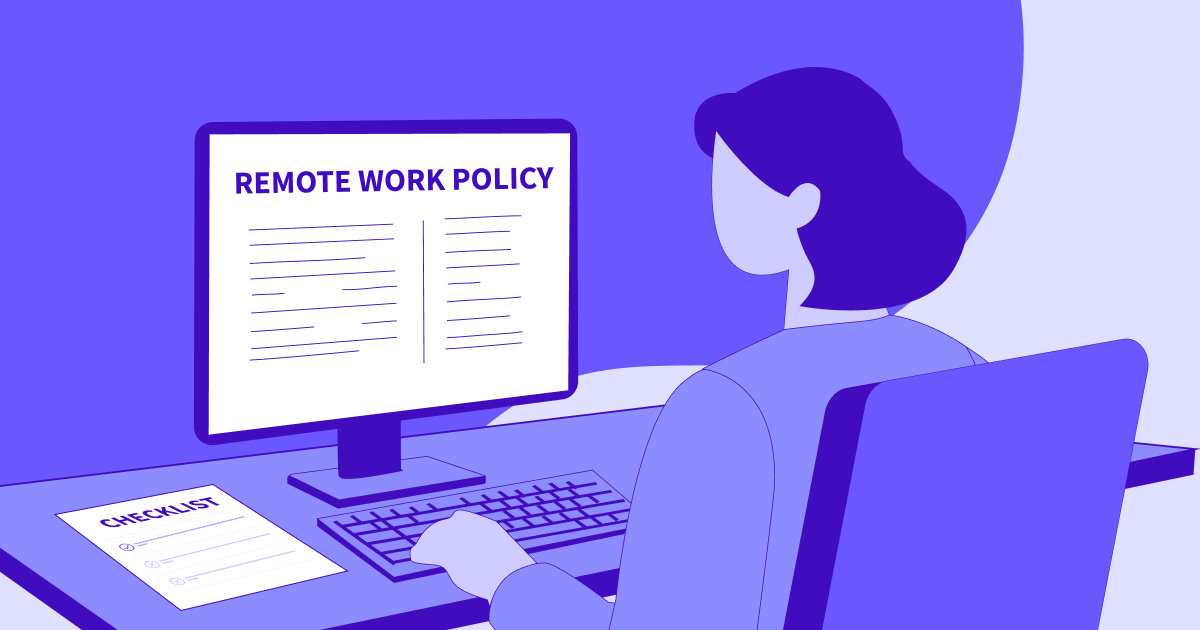How to Build a Work-From-Home Policy that Works



In this article, we’re going to discuss:
- Why remote work policies fail when expectations are left unclear.
- How to balance flexibility with structure across distributed teams.
- What leaders must clarify around eligibility, hours, and performance.
- How tools like employee task monitoring software can support accountability without adding pressure.
Remote work isn’t a temporary fix; it has become the standard way modern teams operate. But, remote setups can quickly create confusion, uneven performance, and trust gaps between employees and managers without a clear structure.
A well-crafted policy ensures that remote work is possible and productive. It sets the standard for eligibility, accountability, and day-to-day operations, without leaving room for guesswork. That structure benefits both employees and managers, making flexibility sustainable.
Tools for tracking work from home can support this structure by providing visibility into workflows and reinforcing shared expectations without pressure. In this guide, we’ll break down how to build a remote work policy that supports productivity and trust.
Inconsistent Remote Expectations Erode Trust & Output
Remote work can quickly become a series of individual interpretations without a documented policy. One employee assumes complete flexibility, while another sticks rigidly to office hours. Some managers monitor too closely, while others disengage entirely. This can lead to frustration, missed deadlines, and unclear team accountability.
A recent survey found that 74% of HR leaders say their hybrid work plans fail, citing misaligned expectations, poor communication, and inconsistent policies as the top culprits. Similarly, nearly half of employees (49%) do not even understand their organization’s hybrid work plan – a lack of clarity that fuels confusion and frustration.
As Gartner’s research director Caitlin Duffy observes, establishing and communicating explicit norms for hybrid/remote teams reduces work friction and boosts engagement. Trust erodes when expectations aren’t clarified, especially in distributed teams with limited visibility. Employees either overcompensate with performative availability or fall behind without realizing it.
The absence of structure also impacts operational leaders. It’s hard to enforce standards or resolve disputes fairly without clear rules. Over time, this gap can lead to unnecessary tension, uneven workloads, or compliance risk.
A remote work policy prevents that drift by aligning everyone to shared rules, processes, and expectations, turning ambiguity into accountability.
How to Build a Clear, Flexible Work-From-Home Policy
A strong work-from-home policy protects team alignment, ensures fairness, and prevents avoidable breakdowns. When thoughtfully written, it becomes a reference point for daily remote work, not just a formality buried in the handbook.
The steps below outline how to design an actionable policy tailored to your operations. Whether your team works remotely full-time or just a few days a month, these principles will help you build clarity without compromising flexibility.
Step 1: Define Eligibility, Scope, & Purpose
Start by outlining who the policy applies to and why it exists. This sets the tone for everything that follows. Employees need to know whether remote work is an occasional privilege, a role-based option, or a permanent setup.
Your policy should clearly define:
- Which roles are eligible to work remotely (e.g., client-facing roles may be excluded).
- Under what conditions remote work is allowed (full-time, part-time, emergency-only).
- Whether frequency is fixed (e.g., one day per week) or flexible within team agreements.
It should also explicitly state that employees remain bound by all other company policies, including security, communication, and performance standards. The goal is to show that remote work is supported and structured.
Step 2: Set a Clear Request & Approval Process
Once eligibility is defined, the next step is to ensure employees know how to formally request remote work and how managers should evaluate those requests.
Outline a repeatable process that includes:
- When and how to submit requests (e.g., number of days in advance).
- Required details (reason, number of days, equipment needs, impact on team schedules).
- What qualifies as an emergency, and how those requests are handled.
- Whether approval can be verbal first, followed by written confirmation.
Clarity here prevents back-and-forth friction. It also gives managers a consistent standard to refer back to, so approvals don’t feel uneven across teams.
Step 3: Outline Remote Work Expectations
Remote flexibility works best when it’s supported with clear standards. Your policy should explain precisely what’s expected of employees so there’s no ambiguity about performance or accountability.
Define:
- Whether employees must follow standard office hours or set their own schedules.
- Communication norms (e.g., availability windows, daily check-ins, status updates).
- Task completion standards and deadline adherence.
- Security expectations (e.g., VPN use, device protection, data protocols).
Reinforce that remote employees are held to the same output and quality standards as in-office staff. And if you use tools to support this, be transparent. For example, remote worker tracking like Insightful can provide visibility without micromanagement. This gives managers confidence in progress while allowing employees to work independently.
Step 4: Address Monitoring & Tools Transparently
Visibility is key to building trust in a remote setup, but how you implement it matters as much as what you track. Your policy should clearly explain the tools used, the data collected, and why it supports employee success.
Specify:
- Which activities or systems will be monitored (e.g., app usage, log-in patterns, task status).
- The purpose behind monitoring (e.g., workload balance, productivity insight, accountability).
- How the data will be used (performance reviews, support planning, emphasize it being against micromanagement).
If you’re using work-from-home monitoring tools, position them as a support layer. Tools like Insightful help teams identify where productivity dips so managers can intervene with coaching or rebalance workloads, not punishment.
Step 5: Confirm Compensation & Legal Considerations
Compensation is a common source of confusion in remote work. Your policy should clearly state that remote status does not alter an employee’s pay, benefits, or job classification unless explicitly defined otherwise.
Include guidance on:
- Whether compensation remains unchanged regardless of work location.
- Any stipends or reimbursements (e.g., internet, equipment, co-working space).
- How local labor laws or tax requirements may vary based on a remote location.
- When HR or legal teams need to review a remote arrangement.
This step ensures your remote policy is legally sound, fair, and transparent, minimizing friction later if disputes arise over entitlements or exceptions.
FAQs
What should a work-from-home policy include?
A complete policy outlines who can work remotely, how often, and under what conditions. It should also define hours, output, security, and communication expectations. Teams using work from home monitoring tools can ensure that policy guidelines are followed by showing where employees are working from, when they’re active, and how work is getting done.
How does Insightful support remote performance tracking?
Insightful (formerly Workpuls) enables teams to track productivity, activity levels, and focus time without disrupting employee productivity. With monitoring software, leaders get a clearer picture of who’s contributing and where support might be needed, especially in distributed environments.
For example, one client used Insightful to rebalance workloads after spotting bottlenecks in cross-functional teams that weren’t obvious over Slack or email.
Why do remote work policies often fail without structure?
Lack of structure leads to misaligned expectations, inconsistent permissions, and team trust breakdowns. Formalizing your policy is a first step, but reinforcing it with employee monitoring software work from home tools like Insightful ensures that those expectations are followed. With real-time insights into when, where, and how work happens, Insightful helps managers uphold consistent rules across locations, roles, and teams.
For instance, without a shared system, one manager may approve ad hoc remote days while another denies them. Insightful eliminates this ambiguity by making remote work patterns and compliance visible to everyone.
Common Mistakes That Undermine Remote Work Effectiveness
Without a clearly defined work-from-home policy, remote operations often fall short of their potential. Here are common mistakes that stall productivity and how to avoid them:
- Lack of Written Guidelines → Leaves employees guessing what's expected.
Fix: Document specific hours, workflows, and eligibility in a central policy. - Inconsistent Use of Monitoring Tools → Undermines trust and leads to compliance issues.
Fix: Clearly explain what tools, like work-from-home monitoring tools, are and how data is used. - One-Size-Fits-All Flexibility → Fails to account for role-specific needs.
Fix: Create tiered eligibility based on job functions and team requirements. - No Performance Benchmarks → Makes output impossible to assess fairly.
Fix: Define output expectations and reinforce them with software.
One company that successfully avoided these pitfalls is Stratum Benefits. As a South African hybrid health insurer, Stratum used Insightful to add structure and visibility to its remote policy.
Instead of assuming how work got done, they relied on real data, monitoring time, focus, and attendance across remote and in-office teams. This enabled them to reduce oversight friction and maintain high performance without overreaching. They benefited from their remote work culture being built on accountability, not micromanagement.
From Unclear Agreements to Reliable Remote Operations
A flexible work environment doesn’t mean working without structure. The difference between burnout and balance, confusion and clarity, is often just a well-crafted policy. Remote teams thrive when expectations are aligned and performance is supported by visibility.
With Insightful, you can:
- Back your policy with actionable performance data.
- Equip managers to lead without micromanaging.
- Give employees clarity and autonomy that fuels long-term success.
Start a 7-day free trial or book a demo to see Insightful in action.
Updated on: July 10th, 2025


.jpg)
.jpg)
